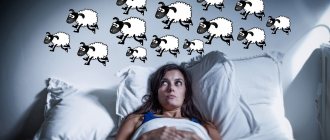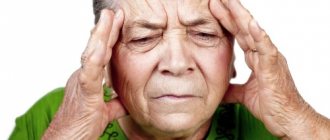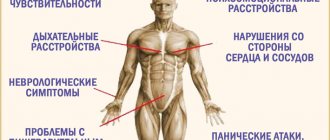Sleep is a physiological state of the human body in which sensitivity to external stimuli is suppressed, muscles relax, and the heart rate and breathing decrease. Its presence is due to circadian rhythms, during which the levels of hormones and neurotransmitters in the central nervous system change. It is believed that at this time there is a restoration of not only the brain, but also other systems of the human body. Therefore, the diagnosis and treatment of insomnia are important issues in modern medicine.
Large studies have been conducted regarding its prevalence, which have revealed interesting facts. About 20-30% of the world's population believes that they have sleep disorders of varying severity. But using the strict criteria discussed below, this number was reduced to 6%. Insomnia is approximately 1.5 times more common in women than men, and most often occurs in patients over 75 years of age, with chronic pain, organic diseases of the central nervous system (for example, tumors) or mental disorders.
What is insomnia?
The most accurate answer to the question of what insomnia is is given by the International Classification of Sleep and Wake Disorders (ICWD), the latest edition of which was released in 2014. According to it, insomnia (or insomnia) is a pathological condition that is manifested by disturbances in the duration or quality of sleep. Moreover, they are not one-time, but are repeated over a long period of time, despite the fact that the patient has all the conditions (time, place, absence of external stimuli) for proper rest.
These recommendations also describe criteria for insomnia that allow it to be separated from other diseases of the central nervous system, as well as short-term conditions (for example, from sleep disturbance due to influenza, due to an overdose of medications or narcotic substances). These include:
- Insomnia includes any disturbances in the processes of falling asleep, sleep itself, and awakening. Therefore, during a conversation with a specialist, he must focus on this and ask leading questions.
- Insomnia does not include conditions when a person deliberately limits himself to sleep. This often happens among students, employees of private companies or travelers.
- If a patient has poor sleep, then he will certainly complain of decreased performance after waking up.
- Sleep disturbance cannot be explained by other third-party factors.
More difficulties have arisen with the determination of sleep in children (especially infants). But special criteria have been developed for them, which the doctor asks the parents about:
- The child actively or passively resists the efforts of relatives to put him to bed at a set time.
- A child cannot fall asleep in a room without his parents present there.
It is also important how often the symptoms occur. To definitely speak about insomnia, it is necessary that the patient had sleep disturbances at least 3 days a week, and this was necessarily accompanied by signs of decreased concentration, fatigue, irritability or daytime sleepiness.
Pharmacotherapy of insomnia - some results and prospects
Patient complaints about poor sleep
are among the most common in the work of not only psychiatrists, psychotherapists and neurologists, but also doctors of all therapeutic specialties in general.
It is these complaints that doctors in clinics and therapeutic hospitals have to listen to from their patients many times a day, and the share of sleeping pills
among all prescriptions written by doctors over the past four decades has generally reached
15%
. Complaints about sleep disorders can be a manifestation of a variety of diseases and conditions: psycho-emotional stress, old age, pathology of internal organs, organic brain damage, substance abuse, depression, pathological anxiety and other mental disorders, etc. - but in any case these patients persistently demand from the doctor assistance in connection with real or imaginary insomnia.
Despite the often exaggerated nature of the complaints of these patients, which do not correspond to objective data, they really need help, since sleep is one of the basic needs of a person and largely determines his satisfaction with life and his health in general. It is also important that sleep disorders, if left untreated, can lead to a large number of severe social consequences.
- reduction in labor productivity, industrial injuries, accidents, road traffic accidents, etc. Likewise, to dramatic consequences, much more severe than insomnia itself, in particular, to abuse and drug addiction, deterioration of cognitive functions, accidents due to morning drowsiness etc., may also result from improper use of medications in the treatment of this disorder.
As you know, insomnia (insomnia)
very widespread - it affects at least 25% of the population; up to 30-35% of adults in economically developed Western countries periodically take sleeping pills. At the same time, some people are not satisfied with the duration of their sleep (often elderly people), others with its depth, others with the speed of awakening, others with the nature of daytime wakefulness, etc. Such a high frequency and wide variety of sleep disorders are due to the fact that sleep is a reflection of a person’s daily life in all its diversity and is influenced by a huge number of different factors - stress and everyday conflicts, anxiety, physical condition, gender and age, taking psychoactive substances, lifestyle, life goals and attitudes, character traits and constitution , social environment, stereotypes of public consciousness and much more. Thus, women complain of sleep disorders more often than men, older people more often than young people, city residents more often than rural residents; people with higher intelligence often have less need for sleep than those with less intelligence.
Over the past few decades, sleep disorders have been intensively studied by representatives of a variety of disciplines - neurophysiologists and specialists in the field of instrumental studies of the brain, neurochemists, pharmacologists, psychiatrists, psychotherapists, and significant progress has been achieved in this area. of polysomnography made a great contribution to the study of this problem.
(including the use of electroencephalography, electrooculography and electromyography), which made it possible to collect information about the phases and structure (architecture) of sleep, as well as how they are affected by various medications.
It has been found that sleep consists of 4-5 wave-like cycles
lasting 80-100 minutes, each of which includes
a phase of “slow” sleep
(accounting for approximately 75-80% of the time) and
a phase of “fast” or paradoxical sleep
(synonyms - rapid eye movement phase, REM phase, REM sleep , sleep with dreams), which accounts for about 20-25% of the time. These phases each play their own role: “slow” sleep provides passive rest and restoration of expended energy, and “fast” sleep provides processing of information accumulated during the day, life conflicts and “letting off steam”, the work of psychological defense mechanisms. For proper sleep, it is important to maintain the correct duration and proportions of these phases, i.e., normal sleep architecture.
With the help of basic biological disciplines, the features of the pharmacokinetics of hypnotic drugs (hypnotics) and the mechanisms of their interaction with brain receptors, which determine the characteristics of the clinical action of these drugs, were studied in detail.
Purpose of this article
— talk about the achievements and changes that have occurred in the field of drug treatment of sleep disorders in the last two decades.
Before embarking on drug treatment for disturbed sleep, it is important to decide whether this case truly belongs to pathology, or is it a variation of normal sleep and, therefore, does not require treatment. According to the International Classification of Mental and Behavioral Disorders, 10th revision (ICD-10), currently in force in our country, the criteria for insomnia are
as a pathological condition are the following signs:
- complaints of difficulty falling asleep, difficulty maintaining sleep or poor quality of sleep;
- presence of sleep disturbances at least three times a week for at least one month;
- a person’s concern about insomnia and its consequences not only at night, but also during the day;
- unsatisfactory duration or poor quality of sleep is painful for a person or significantly impedes his social and professional functioning, since insomnia reduces performance, increases fatigue, irritability, etc.
Thus, not all episodes of sleep disturbances are insomnia.
and require treatment. Thus, transient cases of poor sleep in the elderly or in those who are in a state of psycho-emotional stress, or 5 hours of sleep at night in people who do not suffer from this in any way, are not a disease and do not require drug treatment. In other words, a person's level of satisfaction with sleep is quite subjective and may not correspond to objectively recorded sleep duration. Therefore, the purpose of using sleeping pills and the measure of assessing their effectiveness should be considered not so much the duration of sleep, but rather the degree of patient satisfaction with his night’s sleep - and it depends on maintaining the correct sleep architecture, as well as a number of individual characteristics of the person.
Finding effective and safe sleeping pills
funds has a long history. Despite the apparent simplicity of treating insomnia and the availability of a very large number of sleeping pills (today there are probably up to fifty of them available and used in different countries), this problem still presents certain difficulties. In ancient times, belladonna alkaloids and various herbal sleeping pills were used for this purpose, then opium, morphine and hashish. By the end of the 19th century. the most commonly used sleeping pills were bromides, paraldehyde, opium and chloral hydrate, and in everyday life - alcohol. It is quite clear that the dangers and complications from the use of all these substances were absolutely incomparable with their therapeutic effect.
Since 1903, barbiturates
:
veronal, nembal, seconal, phenobarbital,
etc. (more than 50 analogues in total) - although slightly less dangerous than opium, but still highly toxic, causing a large number of drug interactions and addictive (i.e., capable of quickly becoming dependent ) drugs.
It also turned out that they grossly violate the architectonics of sleep
, suppressing its “fast” phase.
In addition, even relatively small doses of barbiturates in combination with alcohol are extremely dangerous and can lead to death. The ability of these substances to cause a euphoric effect, increased tolerance, addiction, addiction and severe physical dependence is also well known. Although their use essentially ceased almost half a century ago and they are banned in most countries, we can still find echoes of their use in ongoing advertising in a number of CIS countries as hypnotics for Valocordin, Corvalol
and similar drugs containing phenobarbital.
A significant breakthrough in this area occurred in 1960 with the advent of benzodiazepines
.
The first of these was chlordiazepoxide (Elenium)
, then
diazepam
(1963) and
oxazepam
(1965).
Currently, several dozen drugs of this group are used in the world, in particular in our country - diazepam (diazepex, seduxen, relanium, sibazon, valium, etc.), chlordiazepoxide (elenium, librium), phenazepam, oxazepam (nozepam, tazepam) , medazepam (rudotel), nitrazepam (radedorm, eunoctin), flunitrazepam (rohypnol), lorazepam
, etc.
These drugs turned out to be much less toxic
than their predecessors, faster-acting, inexpensive to produce;
they provided a significant increase in total sleep time and its deepening, facilitated falling asleep, caused muscle relaxation and reduced human motor activity during sleep. However, over the years, a number of inherent shortcomings
, the main of which are the following:
- they have a euphoric effect and the ability, with more or less long-term or uncontrolled use, to cause addiction, abuse, mental, and then physical dependence
(although their addictiveness in general turned out to be significantly lower than that of barbiturates); - the risk of developing withdrawal syndrome
when stopping treatment; - the possibility of aftereffects
- morning and afternoon drowsiness, feelings of fatigue, muscle relaxation, decreased reaction and ability to concentrate, especially when using drugs with longer half-life (12-15 hours or more) and active metabolites; - the ability, with long-term use, to impair memory
and other cognitive functions, especially in old age.
As experience in the use of benzodiazepines accumulated, the main difficulty in finding the ideal sleeping pill became clear: if in the pharmacotherapy of “ordinary” diseases (for example, pneumonia, depression or schizophrenia) it is necessary to create and maintain a constant concentration of the drug in the blood for a long time, then in the treatment of insomnia the concentration of the drug should increase as soon as possible after ingestion, persist briefly during sleep, and decrease quickly upon awakening so as not to interfere with daytime functioning.
Thus, the ideal sleeping pill
must have the following qualities:
- quickly absorbed and begin to act;
- rapidly eliminated, i.e., have a short half-life comparable to the average duration of a night's sleep (benzodiazepines of the 1960s had a half-life of 12-24 hours or more);
- do not provide benefits when increasing the dose, which will avoid increasing the dose by the patient himself;
- if possible, do not influence the phases of sleep and maintain its natural structure;
- do not affect memory and cognitive (cognitive) functions;
- have only a hypnotic effect in the absence of muscle relaxant, sedative and anti-anxiety, i.e. have significant selectivity;
- do not cause addiction, addiction or dependence.
Although such an ideal drug has not yet been created, newer generations of sleeping pills are much closer to these requirements than older ones.
As a result of such work in the 1970-1980s. new benzodiazepine hypnotics were created and entered into practice, which to a much greater extent satisfied the above criteria: having half-lives from 2 to 5-6 hours, not giving morning aftereffects and preserving sleep architecture to a much greater extent: triazolam
(halcion),
brotizolam
(lendormin) and
midazolam
(dormicum). The last two drugs have become widespread in the Russian Federation and a number of CIS countries; triazolam is currently widely used in Belarus.
Further progress in the creation of new hypnotics required studying the biological mechanisms of their action. Using molecular biology methods, it was found that the sites of action of these drugs
are the so-called benzodiazepine receptors, which are located in the GABAergic system (GABAergic synapses), as well as on other types of neurons and synapses - serotonin, norepinephrine, dopamine and acetylcholine.
Benzodiazepine receptors are part of a complex that also includes a GABA recognition site and a chloride ion channel (chloride, chlorine anion channel). When hypnotic drugs interact with benzodiazepine receptors, there is an increase in the sensitivity of the GABA-recognition site to GABA and an increase in the flow of chloride ions into the neuron body through this channel, which in turn leads to postsynaptic inhibition in the body of the efferent neuron and presynaptic inhibition in its endings. Since GABAergic synapses are present in a variety of brain regions (cortex, limbic system, cerebellum, basal ganglia, etc.), benzodiazepines can affect a variety of brain systems and functions. Their effects are also carried out by influencing other types of neurons and neurotransmitter systems, primarily serotonin, norepinephrine and dopamine.
Subsequent molecular biology studies revealed that the benzodiazepine receptor
is heterogeneous and consists of several subtypes - omega-1 (w1), omega-2 (w2) and omega-5 (w5) receptors. At the same time, w1 receptors are located mainly in the cortex and subcortical region and are responsible for the appearance of the hypnotic effect, while the other two subtypes are localized mainly in the peripheral nervous system and are associated with other effects of these drugs - muscle relaxant, sedative and anticonvulsant.
These studies served as the basis for the creation in the 1980s. a new class of hypnotics - non-benzodiazepine hypnotics
.
Their current representatives used in the CIS countries are zolpidem
(ivadal) and
zopiclone
(imovan). In Belarus, they have been used only for the last few years and are not yet as widely known to doctors and patients as benzodiazepine sleeping pills.
The most important pharmacodynamic feature of these drugs is their high selectivity
— namely, the ability to interact only with part of the omega-1 benzodiazepine receptor, which is responsible for the hypnotic effect of drugs (in the literature in English, such drugs are called site-specific hypnotics). This selectivity of the drug distinguishes them from benzodiazepine sleeping pills, which interact with all subtypes of benzodiazepine receptors, which results in the presence, in addition to sleeping pills, of a number of other effects undesirable in the treatment of insomnia - muscle relaxant, sedative, anti-anxiety and anticonvulsant.
Features of the pharmacokinetics of modern sleeping pills are very rapid and complete absorption from the stomach and the rapid onset of peak concentrations in the blood plasma, which leads to the recommendation to take these drugs immediately before going to bed. The most important feature of modern sleeping pills is their very short half-life.
- about 5 hours for zopiclone and about 3 hours for zolpidem (for comparison: for diazepam, nitrazepam, flunitrazepam - more than 24 hours, elenium - 18-20, phenazepam - 12-15, tazepam - about 10 hours).
This feature of modern drugs is due to rapid awakening, the absence of morning and daytime aftereffects in the form of drowsiness, decreased performance, deterioration of memory and other cognitive functions, as well as motor coordination. All this allows the patient to perform his duties and lead a normal lifestyle from the very morning.
Another important advantage of modern sleeping pills is that, due to their selectivity, they preserve and restore sleep architecture
. This is manifested by the fact that the patient dreams at night, waking up in the morning cheerful and rested. As for the ability of non-benzodiazepine hypnotics to cause addiction and dependence, this possibility cannot be ruled out. This issue is currently being studied; we can only say that compared to older and non-selective benzodiazepines, this danger is significantly lower.
In any case, the duration of taking sleeping pills should not exceed 7-10 days
; if the result is not achieved, then insomnia has deeper causes that must be identified. This could be alcohol and tobacco abuse, depression, somatic illness, adaptation disorder (reaction to stress), pathological anxiety, unhealthy lifestyle, etc.
Thus, in recent years, significant progress has been made in the pharmacotherapy of sleep disorders. Each new generation of drugs is characterized by increasing selectivity, effectiveness and safety. There is no doubt that further progress in biological research into the mechanisms of sleep and the interactions of drugs with brain receptors will lead in the future to the creation of new hypnotic drugs, even more specific and safe.
Evsegneev R. A.
BelMAPO. Published: Medical Panorama magazine No. 6, December 2006.
Symptoms of insomnia
Symptoms that occur during insomnia are usually divided depending on when they bother the patient. The first group of symptoms is called presomnia disorders. It includes disorders that occur during the sleep phase:
- the presence of “rituals” (actions) that must be performed;
- worries that sleep will not come;
- fear of a cold bed;
- the emergence of disturbing memories or thoughts;
- increased motor activity (especially of the lower extremities), frequent changes of position in bed;
- interrupting sleep even with quiet sounds;
- delaying the time to fall asleep to 30-120 minutes.
The second group of signs of insomnia is frequent waking up in the middle of the night. Moreover, it can be caused either by small external stimuli (for example, the sound of a car passing near the house, or a conversation at the other end of the apartment), or by internal triggers (the urge to urinate, pain, a feeling of shortness of breath or palpitations). Often each such awakening lasts more than 30 minutes.
The third group of symptoms is called post-somnia, and combines symptoms that arise due to waking up too early (an hour or two before the required time). In patients, it is often accompanied by the need to go to the toilet, after which they can no longer sleep.
And finally, the symptoms of insomnia necessarily include the patient’s daytime complaints:
- feeling of chronic fatigue;
- drowsiness that occurs even before lunch;
- decrease in cognitive abilities, concentration, speed of task completion;
- frequent mistakes that the patient makes at work or school;
- decreased mood, tendency to aggressiveness or irritability;
- lack of motivation and initiative;
- the patient’s anxiety regarding his sleep and its quality;
- headache;
- loss of appetite and disorders of the digestive tract (nausea, feeling of heaviness in the stomach);
- difficulties in social communication;
- presence of muscle tension.
Symptoms
Insomnia manifests itself as a variable combination of the following phenomena:
- difficulty falling asleep when desired and physically necessary;
- frequent awakenings at night, followed by difficulty falling asleep;
- waking up very early, inability to fall asleep again in the pre-dawn hours;
- inability to maintain a traditional sleep schedule;
- inability to fall asleep if certain conditions are not met;
- feeling tired in the morning;
- fatigue, constant fatigue throughout the day;
- general malaise, weakness.
Associated symptoms:
- problems with concentration;
- memory impairment;
- social or family conflicts;
- poor performance of professional tasks;
- learning difficulties;
- mood swings;
- irritability;
- hyperactivity or, conversely, lethargy;
- impulsiveness, inconsistency;
- aggressiveness, hostile attitude;
- decreased motivation, lack of initiative;
- tendency to make mistakes.
With insomnia, there is a change in the functioning of the autonomic nervous system. The patient experiences an increase in heart rate, heart rate variability, increased metabolism, and a rise in body temperature. At the biochemical level, an increase in production and increased release of adrenocorticotropic hormone and cortisol is determined.
Treatment methods for insomnia
If we consider methods of treating insomnia, we can highlight several of the most important areas:
- Correction of risk factors. This includes adequate treatment of concomitant diseases.
- Sleep hygiene. Specialists spend a significant part of their time explaining to the patient what not to do before bed and how the bedroom should be arranged.
- Cognitive technique. The patient needs to be told about how sleep occurs, what phases it consists of, and talk about new research in this area. This will allow him to have a more realistic assessment of his condition, which will relieve anxiety and uncertainty.
- Drug therapy. In clinical practice, the most commonly used drugs are benzodiazepines and central histamine receptor blockers.
- Folk remedies. Used as auxiliary means.
Causes of insomnia
Insomnia, as a rule, is a syndrome that requires a mandatory search for the cause of night sleep disturbance:
- stress (psychophysiological insomnia),
- neuroses,
- neurological diseases, especially those accompanied by pain symptoms,
- somatic diseases,
- alcohol consumption,
- external unfavorable conditions (noise, humidity, etc.), shift work, change of time zones.
Most often, insomnia is associated with mental factors (the most important role is given to anxiety and depression) and therefore requires treatment of the underlying cause that caused sleep disturbances.
Causes of insomnia
Numerous studies conducted in Europe and North America have identified the main causes of insomnia. These include:
- congenital features of brain functioning;
- frequent stressful situations;
- time zone shifts in patients who frequently travel between countries and continents;
- unfavorable conditions for falling asleep;
- presence of chronic pain syndrome;
- long-term use of certain medications (antidepressants, psychostimulants, antipsychotics, hormones);
- drinking coffee or strong tea immediately before bedtime;
- mental disorders;
- organic diseases of the central nervous system (tumors, consequences of strokes, hemorrhages, Parkinson’s disease);
- skin pathologies that are accompanied by itching;
- low socioeconomic status of the patient.
The combination of the effects of these factors leads to a decrease in the functional activity of the inhibitory system in the central nervous system, which is manifested by a decrease in the production of certain neurotransmitters. The second important factor is the activation of the sympathetic nervous system (with an increase in the concentration of catecholamines in the blood). This promotes increased physical activity during the period when the patient should completely relax and fall asleep.
Types of insomnia
If a person suffers from insomnia, you need to visit a somnologist. Sleep disorders are classified according to etiology, duration and intensity. Insomnia happens:
- Behavioral. Occurs when incorrect attitudes are formed. A person does not fall asleep with the lights off, the TV on, or without drinking warm milk at night.
- Adaptive. It can appear in every person. Its causes include acute stress: moving to another city, serious illness, unfinished homework for schoolchildren.
- Emotional or psychogenic. A man or woman cannot sleep due to disturbing thoughts and feelings. They need to distract themselves from negative emotions and “turn on” pleasant memories. Combating insomnia with this method will allow you to relax and fall asleep.
- Teenage. Develops due to the physiological immaturity of the brain at this age.
- Idiopathic. Its cause remains unclear.
- Menopausal. Refers to one of the symptoms of menopause. Accompanied by hot flashes, tachycardia, nervousness, sweating. In severe cases, a depressive, depressed state develops.
When asked whether it is possible to die from insomnia, doctors answer in the negative. It will not cause death, but can lead to psychotic disorders.
Insomnia can be acute, subacute and chronic. Acute – lasts 7 days. Subacute – accompanied by disability, lasts from 7 to 21 days. Chronic – appears in patients with mental illness, severe somatic pathologies or anxiety disorders.
Severe insomnia worsens the condition, lowers mood, and causes exacerbation of chronic diseases.
Insomnia
This is a disruption of the normal sleep-wake cycle. There are three types of insomnia:
- Presomnicheskaya. A person does not fall asleep for a long time.
- Intrasomnic. Characterized by frequent night awakenings, fears, and nightmares.
- Post-somnia. A person does not feel rested and feels exhausted after waking up.
Causes of insomnia include taking antidepressants and changing time zones.
Hypersomnia
With hypersomnia, a person sleeps more than 8-9 hours. A characteristic sign of this condition is constant sleepiness during the day and difficulty waking up in the morning. Insomnia is often caused by chronic stress, brain tumors, and cerebrovascular accidents. Any form of these sleep problems requires medication.
Parasomnia
This is what dissociative sleep disorders are called. These include:
- Sleepwalking.
- Nocturnal diuresis.
- Sleep paralysis.
Episodes of parasomnia are short-lived and disappear from a person’s memory. It mainly develops in children under 12 years of age.
Episodic insomnia
Refers to frequent complaints. Its causes can be positive or negative emotions. Family quarrels, job loss, and weddings often lead to episodic insomnia. This condition occurs in teenagers who spend a long time at the computer.
Short-term insomnia
This type of dissomnia is also called situational. It lasts from 1 to 7 days. Its causes are any stress overload. After the situation is resolved, the person’s condition improves and the daily routine is restored. This disorder is treated with sedatives or sleeping pills.
Chronic insomnia
This condition is not an independent disease. It is a manifestation of somatic, psychological or mental pathologies. The main causes include schizophrenia, panic attacks, depression, arthrosis, osteochondrosis with pain syndrome.
A person cannot sleep, falls asleep only in the morning, and when falling asleep wakes up every 2-3 hours. During the day he feels tired and overwhelmed.
Treatment of chronic insomnia
Insomnia is an important economic problem, as it leads not only to a decrease in the quality of life, but also to significant losses that both patients and their companies receive due to low productivity. Despite this, for a long time, treatment options for insomnia remained fairly limited. Patients were advised to avoid stressful situations, avoid alcohol or coffee after lunch, and use earplugs to minimize the impact of external irritants on the body. Then sleeping pills appeared on the pharmaceutical market, which helped the patient to sleep, but had their own disadvantages (for example, they could lead to the development of addiction).
Now the problem is being considered more comprehensively. For the doctor who conducts the initial diagnosis, it is necessary to determine all possible factors that could provoke the development of insomnia. The possibility of the presence of other diseases of the central nervous system that could produce similar symptoms is taken into account.
Taking into account the diagnostics performed (which includes CT, MRI, EEG of the brain, consultation with other specialists), before starting treatment, the doctor must answer the following questions:
- Does the patient really have true insomnia, or are his complaints psychosomatic in nature?
- In what comfortable conditions does the patient rest at night? And does he set aside enough time for his sleep?
- Was insomnia caused by the patient's lifestyle? And if so, what factors had the most impact?
- Is the patient taking psychoactive drugs?
- Is the patient taking medications whose side effects could cause the development of the pathological condition?
- What concomitant diseases could contribute to the development of insomnia?
The most complete answers to these questions will allow the doctor to begin effective treatment of chronic insomnia.
Methods for preventing insomnia
In order for the treatment of insomnia to be effective and the results to last for a long time, the patient must remember to prevent relapses. The main rule is to adhere to a daily routine; the body must know when to fall asleep and wake up.
It is necessary to eat properly and not overeat in the evening. During the daytime, it is advisable to limit hours of sleep. A person needs to engage in moderate sports, as well as master methods of psychological and physical relaxation. Alcohol cannot be taken “for relaxation”; it loads the nervous system and does not allow the body to rest.
The causes of insomnia are varied; many neurological diseases can cause a lack of adequate sleep. If the cause of insomnia is cervical osteochondrosis, then be sure to get a massage and buy the right pillow.
Treatment of insomnia in the elderly
In older patients, insomnia occurs more often against the background of chronic diseases. These pathologies are often accompanied by pain, frequent urge to urinate at night, itching and other symptoms that lead to awakening. Therefore, treatment of insomnia in older people necessarily includes the following points:
- Adequate drug pain relief. Nonsteroidal anti-inflammatory drugs (NSAIDs) or opioids are used.
- Selection of pharmacological therapy to compensate for cardiac, renal or liver failure, as well as to reduce blood pressure and normalize blood sugar levels.
- Timely treatment of degenerative diseases of the central nervous system, as well as mental disorders.
- If there is a problem with urination, the urologist must determine the cause.
Required duration of sleep
The average duration of sleep is usually 6-8 hours a day, but fluctuations are possible: with sleep disorders, its duration can range from several minutes to several days.
The duration of sleep in newborns, adults and the elderly is 12-16, 6-8 and 4-6 hours per day, respectively. Sleep duration of less than 5 hours (hyposomnia) or disturbance of physiological structure are considered risk factors for insomnia. Sleep is the main guardian of human health and mental well-being. It is not without reason that during interrogations the method of psychological pressure was used - sleep deprivation for up to several days. In this state, a person loses clarity of consciousness and can enter a state bordering on confusion.
Treatment of insomnia in women
In women, insomnia often first appears during menopause. Therefore, patients with menopausal symptoms need additional consultation with a gynecologist. He prescribes testing of hormonal parameters (estrogens, progesterones), and if there are deviations, it is necessary to take corrective therapy.
Also, treatment for insomnia in women often includes behavioral therapy. In individual or group (for example, when the whole family comes) sessions with a psychologist, sleep problems are discussed, and the doctor carefully explains what the main factors in the occurrence of insomnia are and how they affect the functioning of the nervous system. At the same time, each lesson is given a certain homework, which helps to gradually modify the patient’s lifestyle.
general information
The leading criterion for diagnosing insomnia is the presence of one or more disorders: presomnic, intrasomnic, post-somnic.
Presomnia disorders are, first of all, difficulties falling asleep. On average, it takes a child and teenager no more than 15 minutes to fall asleep. This period can last up to 30 minutes for an adult. People who suffer from insomnia may take more than 2 hours to fall asleep. Another feature of presomnia disorders is the formation and implementation of “protective” rituals, for example, repeatedly checking whether windows and doors are closed. Very often the patient has obsessive fears, for example, fear of the bed or confidence in lack of sleep.
Intrasomnia disorder refers to regularly occurring intermittent sleep at night. A person often wakes up in the middle of the night and cannot fall asleep for a long time. Accordingly, the time spent awake increases and the hours of rest decrease.
Post-somnia disorders involve very early awakenings, often before dawn. In this case, the person cannot fall asleep again. Accordingly, there is a shortage of time necessary to recuperate.
It should be borne in mind that patients with insomnia, unlike people with undisturbed sleep, cannot objectively assess their condition. They are often convinced that they take a very long time to fall asleep, although this is not true. Or they are sure that they sleep very little, although the duration of their sleep fits within the norm.
The diagnosis of insomnia also requires that sleep disorders are not one-time, but last for quite a long period of time. At the same time, conditions must be created for a person to ensure a normal night's rest. Therefore, we cannot talk about insomnia if the subject deliberately deprives or limits himself in sleep (for example, works in two shifts). Or, due to his professional activity, he does not have a comfortable atmosphere for falling asleep (for example, he works as a truck driver).
Diagnosis requires that sleep problems have a negative impact on waking hours. If an individual sleeps very little, but feels great during the daytime, he is physically energetic, emotionally stable, and has no problems in the cognitive sphere, it cannot be said that he suffers from insomnia. It must be taken into account that each person has an individual need for the duration of sleep, so assumptions about insomnia are inappropriate if, after a five-hour night's sleep, the person is alert and active all day.
Drugs for the treatment of insomnia
Pharmacological therapy for insomnia has become one of its main components. Depending on the medications chosen, it is possible to remove the patient’s fear, unnecessary thoughts, or even significantly suppress brain activity, which leads to rapid and deep sleep.
Often, benzodiazepines are prescribed for this purpose - medications that act on gamma-aminobutyric acid (GABA) receptors in the central nervous system. This provokes a decrease in neural excitability, which leads to muscle relaxation, calms the patient and significantly increases the desire to sleep. To correct insomnia, it is recommended to use triazolam, flurazepam, quazepam, temazepam or estazolam. However, due to the risk of developing addiction, they should not be prescribed for a long period (more than 1-2 weeks).
Z-medicines (zolpidem, zaleplon) are also used - drugs for the treatment of insomnia, which are similar in their mechanism of action to benzodiazepines, but have a different molecular structure. Therefore, they can be used over a longer course (continuously for up to 1 month). The incidence of side effects is lower and tolerability is better than that of benzodiazepines.
Another important group of drugs that are used to treat insomnia are central histamine receptor blockers (doxylamine). These drugs block one of the most important mechanisms of neuronal stimulation, which leads to inhibition of processes in the central nervous system and the development of severe drowsiness. Today, a number of international recommendations recommend their use for insomnia, but their effectiveness in independent studies has not yet been definitively proven.
The use of melatonin analogs, a hormone responsible for regulating the circadian rhythm in the human body, is considered promising. This allows you to increase sleepiness in the evening, and also reduces the frequency of night awakenings and improves sleep quality.
Medicines for insomnia
The most popular medications for insomnia in Russia are:
- Melaxen. Natural sleep and well-being during the day.
- Persen. A balanced combination of plant extracts promotes easy falling asleep and restful sleep throughout the night.
- Novopassit. The composition contains natural ingredients with a mild hypnotic effect - valerian and lemon balm, mint, hawthorn, St. John's wort, elderberry, hops.
- Donormil. It is effective and recommended even for pregnant women, but can cause severe daytime sleepiness.
- Triazolam, midazolam. Used for problems falling asleep.
- Nevoheel and Calm. Homeopathic medicines.
- Corvalol and valocordin.
- Nozepam and phenazepam are potent drugs that also cause daytime sleepiness.
- Phenobarbital. The most powerful narcotic sleeping pill.
Insomnia Treatments
In pharmacies and online stores you can easily find a variety of treatments for insomnia: tablets, drops, ointments. However, keep in mind that all of them are not effective medicines, but are sold as dietary supplements. This means that the manufacturer is not obliged to conduct studies in which it is necessary to prove the effectiveness of the product, but it is enough only to show the safety of this product for health.
Some manufacturers also offer devices for magnetic therapy or low-frequency electrotherapy. They are portable enough to be used not only in physical therapy offices, but also at home. But the evidence base in them is insufficient, which allows them to be used only as an addition to the main methods of treatment.
Treating insomnia at home
An important element is treating insomnia at home. This includes sleep hygiene - a set of rules and recommendations regarding the organization of patient behavior. The purpose of the technique is to create conditions for the longest and most stable sleep. Among its provisions, the following should be highlighted:
- It is necessary to go to bed and get up at the same time on both weekdays and weekends.
- An hour to an hour and a half before falling asleep, avoid excessive mental or physical stress.
- Dinner doesn't have to be filling. It is better to eat no later than 2-3 hours before bedtime.
- In the afternoon, do not drink coffee, strong green tea, cola or energy drinks.
- Make your sleeping area as comfortable as possible. It is often necessary to change the mattress or buy an orthopedic pillow.
- When the patient has already climbed into bed, he needs to limit reading from a smartphone, phone, laptop or watching TV.
Fighting insomnia
Like any disease, insomnia can be treated with a combination of medicinal and non-medicinal methods. Treatment should include a set of simple measures, ultimately leading to normal work and rest. It is important to minimize the risk of stressful situations and reduce the influence of factors that in one way or another change the usual course of normal life.
Changes in daily routine
Sometimes it is enough to change very little in your life to get rid of insomnia.
For example, you can do the following yourself:
- Avoid using any stimulants: from alcohol and cigarettes to coffee. If these habits are difficult to “get rid of” completely, then at least you should not abuse them in the afternoon. Alcohol and nicotine consumption should be stopped approximately 5-6 hours before bedtime. With drinks containing caffeine, everything should be even stricter: do not drink more than 3 cups of coffee or glasses of tea per day and stop consuming them 7-8 hours before bedtime.
- Don't eat before bed. The last meal (a light dinner containing about a tenth of the daily calorie intake) should be no later than 3-4 hours before going to bed.
- Do not work at night for more than a month (second shifts, overtime, etc.), and after a month of such work you must do without it for at least two months. This will restore melatonin production in the body.
- Try to do all physical activity (workouts, active recreation, etc.) in the first half of the day.
- Create comfortable sleeping conditions - a comfortable bed, absence of bright light and loud sounds, fresh air.
- A couple of hours before bedtime, stop engaging in complex mental activities and get ready to relax; you can listen to relaxing music or watch a calm movie.
Various exercises for insomnia
Many sleep specialists suggest using various types of physical exercises, special procedures or some special physiological practices to solve the problem of poor sleep.
These include, for example, yoga, breathing exercises, acupuncture, etc. Their effectiveness can be quite high, but they only enhance the actions of the previously proposed method for correcting the daily routine. By themselves, such activities will not give the desired result, in addition, they all have contraindications in one form or another.
Application of traditional medicine
Includes the use of tools that have been used for several centuries and have proven themselves, namely:
- using various soothing infusions of herbs (mint, hops, lemon balm, rose hips or a combination thereof) before bed;
- drinking warm milk and honey before bed;
- using tinctures of valerian or motherwort (don’t be confused by the alcohol in them, the dosage of these tinctures is several dozen drops);
- use of scented pillows;
- other folk remedies.
Treatment with such means does not pose any threat to the body, however, they are also the “backdrop” against which measures aimed at changing lifestyle are carried out.
Use of medications
Medicinal methods involve the use of sleeping pills containing methylphenyl groups (Zopiclone, Zaleplon and others). Like any products of this type, they should be used only as prescribed by the doctor conducting the treatment.
Their use is limited in time due to the high likelihood of addiction. Treatment of insomnia primarily consists of the correct approach to work and rest, as well as correction of the daily routine.
Treatment of insomnia with folk remedies
In folk medicine there are a number of remedies that have a sedative effect and also remove stress and excessive emotions. Using them a few hours before falling asleep can improve the quality of your sleep. The most frequently used of them are:
- Valerian infusion. It is necessary to pour 2 tablespoons of peeled and crushed plant root into about 400-500 ml of hot water, and leave for 30-45 minutes in a cool place. Then you can drink half a glass 1.5 hours before bedtime.
- Melissa tea. This plant has long been known as an effective remedy for the development of neuroses, depression and sleep problems against their background. This tea can be found in pharmacies under various brand names. To brew it, you need to add a bag or a teaspoon of lemon balm to 250-300 ml of boiling water and cover with a lid. After 15 minutes, the tea is ready to drink.
- A bath with herbs (calendula, oregano, lemon balm) helps relax the body and relieves muscle fatigue. The most optimal water temperature is 37-38 degrees. You can take it within 15-30 minutes after dinner. This method is not recommended for patients with organic diseases of the central nervous system.
- Aromatherapy. Soft odors have a relaxing and calming effect on the patient's body. Therefore, before going to bed, it is recommended to rub aromatic oils on your temples or forehead. It is recommended to use chamomile, rosewood, valerian or anise.
However, treatment of insomnia with folk remedies is not always effective. Especially if insomnia only accompanies other diseases. In such cases, there is no need to postpone a visit to a qualified specialist.
Sleeping pillow - a natural method for sleep
A herbal pillow is a great way to relieve tension and stress. It is made from fern, laurel, hazel, immortelle, oregano, a drop of geranium, as well as pine and pine needles. You can add dry lavender, hop cones, mint, rose petals.
Herbal pillows are placed next to the main sleeping item, or placed on the radiator - this way the aroma will spread throughout the room. You need to select a combination of herbs from the presented components according to your own taste. Many people are irritated by the smell of geranium, others do not like oregano, and still others do not like mint.
Reviews about the treatment of insomnia
On social networks and health websites, you can find various reviews about the treatment of insomnia. As can be seen from them, the causes and methods of treating the disease are different.
Irina, 59 years old: I started having sleep disorders about 3 years ago. At first I didn’t give it any importance, but then I noticed that I had lost weight, my skin became drier and hotter, and my heartbeat began to bother me frequently. I turned to a neurologist, but after an examination he sent me to an endocrinologist. I was diagnosed with thyroiditis, and insomnia appeared due to hormonal imbalance. After the operation, all problems quickly disappeared and do not bother me anymore
Sergey, 48 years old: The last few months I have had difficulties at work. And this had a detrimental effect on my sleep. I could wake up 2-3 times during the night, all sorts of thoughts would bother me, and then I would walk around tired all day, which is why I often made stupid mistakes. My doctor referred me to a sleep specialist. After the examination, he gave me some important advice regarding getting ready for bed, and also prescribed sedatives. He also suggested that if the initial treatment did not help, I should sign up for special psychotherapy classes. As a result, after a few weeks my sleep problems completely disappeared












